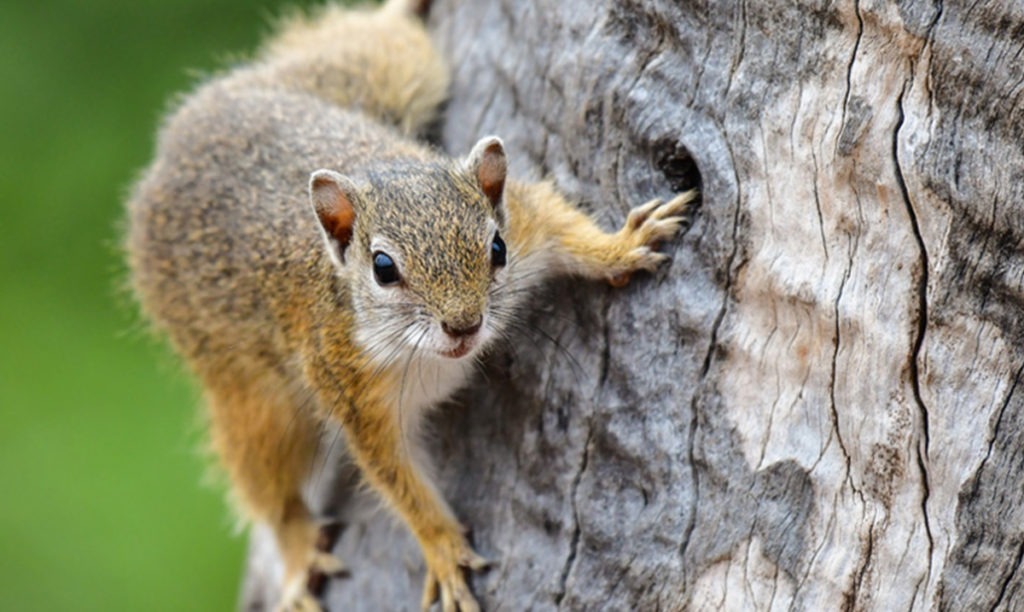
Why You Need To Be Hunting Squirrels Right Now
A summertime squirrel hunt is a great way to sharpen your shooting skills, tune up your gear and scout for deer.
By Andrew McKean
What if I told you about a hunting opportunity that’s happening right now, which offers abundant access to productive land, requires a minimum of technical gear, and provides the chance to bring home tasty meat that is routinely overlooked for its palatability?
You’d probably think I was blowing smoke, but I’m talking about one of the most neglected and productive hunts in the U.S.—for common tree squirrels.
Squirrel seasons start now, in the lazy days of late summer, giving you time (and an excuse) to get out in the woods to scout for deer while also ground-truthing the gear that you’ll rely on all autumn.
But you don’t need an excuse to go squirrel hunting. The first argument in its favor is that squirrels live almost everywhere, from the leafy hardwoods of the East to the piney woods of the South to the mountains of the West. Squirrel hunting is also a great way to introduce new shooters to small-game hunting.
The two squirrel species most often pursued by hunters are the largest and most widely distributed: the fox (or red) squirrel, and the gray squirrel.
While peripheral habitats can hold squirrels, you’ll have the best luck finding summertime squirrels in their core habitats of nut-producing hardwoods, especially oak and hickory stands. But here’s the other appeal: hardwoods define a lot of public land east of the Mississippi, from small tracts of county land to larger state game lands and wildlife management areas, to big U.S. Forest Service tracts.
Find hardwoods, and you’ll almost certainly find squirrels. But don’t neglect private land, either. Your chances of getting permission to hunt a patch of farm-country hardwoods for squirrels is orders of magnitude better than getting on that same land for deer.
Summer Squirrel Tactics
Now that you know where to find them, how do you hunt squirrels? You’ll change tactics once the leaves drop, but for summertime squirrels, when the critters can be hidden in the dense green foliage, the best approach is to first walk and then sit and listen for rustling high in the branches.
Patience is a virtue with this style of hunting, because not only must you positively identify that the movement is being made by a squirrel, but you must wait for a clean shot.
Try sitting near the top of a steep hillside that drops into a ravine or creek drainage. Your elevation will provide you with a better view of the upper limbs of trees that hold squirrels, and you can look over several acres of trees on the slopes below you.
Another benefit to hilltop stands, especially for rifle hunters, is that your shots will be traveling safely downward, often with a tree trunk or limb behind the squirrel to stop your bullet.
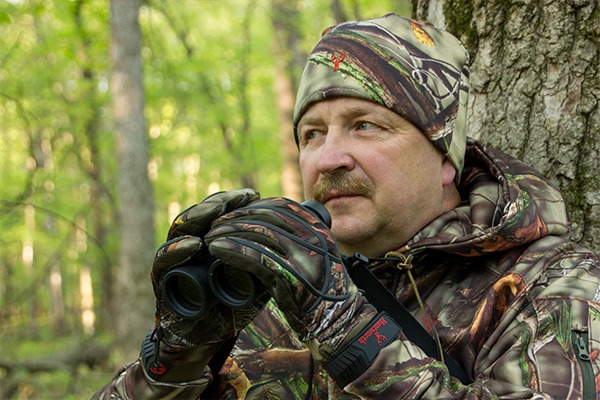
In summer, use a low-power 8×24 or 8×32 binocular to scan areas where you hear or see leaves moving, then be ready to follow up positive identification with a rifle shot.
A small binocular—either an 8×24 or 8×32—is useful for this sort of surveillance. Scan areas where you hear or see leaves moving, then be ready to follow up positive identification with a rifle shot.
Quick tip: If a squirrel keeps running around to the opposite side of a tree trunk, and won’t give you a clean shot, try placing your jacket on the ground, then walk to the other side of the tree. Squirrels often can’t decide which side of the tree is safe, and their indecision will give you an open shot.
The perfect set-up for this type of hunting is a .22 rimfire topped with a 4-power scope. Your shots won’t be much over 50 yards, but the scope enables you pinpoint aim, an important advantage when you often see only pieces and parts of leaf-hidden squirrels. Your goal should be head shots.
If you’re a morning hunter, get in the woods early and sit against the base of a large tree with a wide vantage of the woods around you. Squirrels are often active on the forest floor in the mornings, and you can have good shooting as long as you can move quietly from place to place. Once you’ve shot a couple times, squirrels will get nervous and remain in the sanctuary of the treetops.
This is also a good time to try calling. If you know squirrels are hanging out of sight in the treetops, blow or push a chatter call. You’ll need to experiment with the rhythm and volume (as well as various brands), but the idea is to mimic the sound of an agitated squirrel, causing the real chatterboxes to show themselves, often with their tails puffed out, standing on an exposed limb.
A call is a great device to use with a buddy. Your friend calls, you get ready to shoot. After you’ve bagged a tree rat, switch jobs and call another one.
Note: Before hunting squirrels, it’s important to understand how to properly field dress and process. Learn to skin and prepare squirrels in this article.
Later Season Squirrels
Visibility in hardwoods improves greatly once fall arrives and trees drop their leaves. Squirrel hunting can be red-hot for the first few weeks of the bare-branch season.
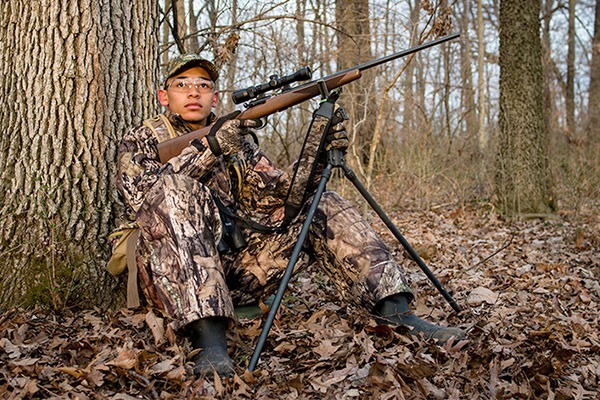
Find a quiet place to sit, let the woods settle down then listen. In summer, you’ll likely hear squirrels in the leafy treetops. Once leaves drop, listen for squirrels rustling leaves on the forest floor.
This is the nut-gathering season for squirrels, and they’re working overtime to store acorns, hickory nuts, and chestnuts for winter consumption, so they’re often visible and vulnerable.
If summer was .22 season, the fall is a better time for a shotgun. Walk the woods and look for snap shots on the forest floor as squirrels run from tree to tree and scamper up trunks. But if you prefer a rifle, then sit on a hillside, wait for the forest to settle down from your intrusion, and then take longer shots at squirrels pausing from their nut-gathering mission.
This can also be a wait-and-listen game, only at this time of year, you’re listening for the loud rustle of squirrels moving through dried leaves. You’d be amazed how often a 2-pound squirrel can sound like a 200-pound whitetail buck moving through the woods.
Guns and Loads
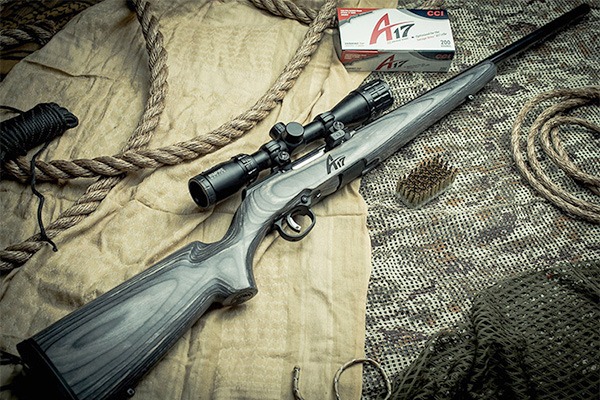
While a .22 Rimfire rifle is an excellent choice for squirrels, when you want a little more reach, consider a scoped .17 rimfire, like Savage’s A17.
The most effective all-around squirrel gun is a scoped .22. You want a rifle that can repeatedly stack shots inside a 2-inch bullseye at 50 yards. Good options include the durable Ruger 10/22, Browning’s T-Bolt, or Marlin’s Model 60 or 795.
An accurate .22 pistol, such as Browning’s Buck Mark, topped with a red-dot sight is another great squirrel rig. If you want to opt for a little more range, consider a .17 rimfire; the light, fast Savage A17 in .17 HMR is a good choice.
A suppressor is a smart addition, because its blast-taming muzzle keeps you from announcing yourself to squirrels with every shot you take.
For shotguns, there’s no need to go heavier than a 20 gauge, and a 28 gauge or even .410 is a better choice. The Federal’s Heavyweight TSS (Tungsten Super Shot) is a wonderful squirrel load. Designed for turkeys, the size 9 shot delivers great penetration and range and is a good choice for a walk-about squirrel hunter who doesn’t want to lug around a heavy shotgun.
Other Gear Considerations
A vest with a bloodproof game bag, a good knife, some snacks, water and a binocular round out your gear needs.
Here’s one more: a good shooting stick to settle your gun for longer shots. Look for a telescoping monopod or tripod with a head that fits the forend of your rifle, and then use it on different pitches of slope or any time you can’t find a tree trunk or other support to stabilize your gun.
About the Author
Andrew McKean is a longtime outdoor writer and the former editor-in-chief of Outdoor Life. He lives in northeast Montana with his family and yellow Lab. You can follow his adventures on Instagram @aemckean or on Facebook @andrew.mckean.77
Special thanks to StepOutside.org for providing this insightful content.
Check out these Delicious Squirrel Recipes



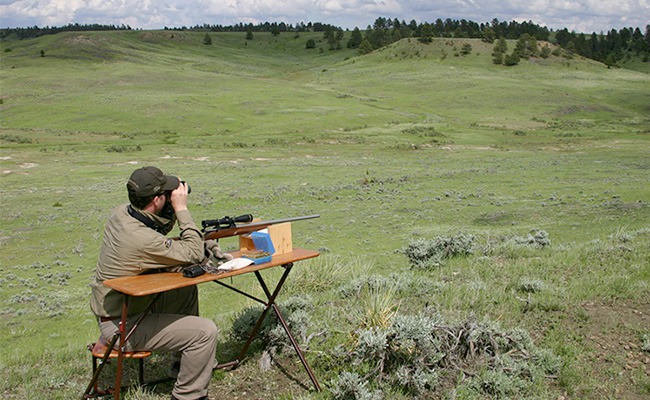 Photo Courtesy of Bob Robb[/caption]
When it comes to gear, precision is essential. A reliable rifle with a suitable caliber, such as a .22 or .17 HMR, is commonly used for prairie dog hunting due to its accuracy and effectiveness. Optics, such as scopes or binoculars, help spot these small targets from a distance. Additionally, a comfortable and sturdy shooting rest can assist in maintaining stability and improving shot accuracy.
Photo Courtesy of Bob Robb[/caption]
When it comes to gear, precision is essential. A reliable rifle with a suitable caliber, such as a .22 or .17 HMR, is commonly used for prairie dog hunting due to its accuracy and effectiveness. Optics, such as scopes or binoculars, help spot these small targets from a distance. Additionally, a comfortable and sturdy shooting rest can assist in maintaining stability and improving shot accuracy.